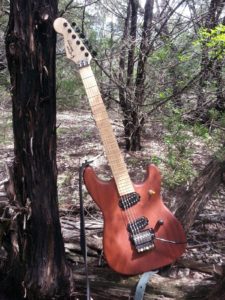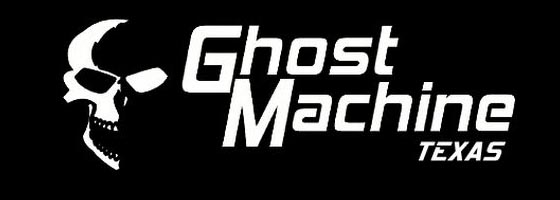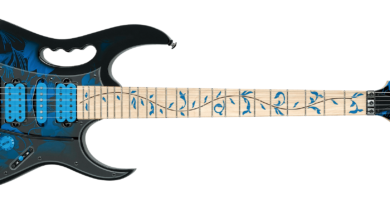Ghost Machine Guitars Custom Build
 What do you say we have another guitar review?! I love reading guitar reviews from people like Simon, it makes it so much easier when I’m buying a new guitar. This time we are going to take a peek at a custom build that I commissioned from Ghost Machine Guitars, here in Texas. After checking out Ghost Machine earlier in 2015, we started going over some ideas for a bit of a departure from the common types of guitar I usually buy. OK, you got me… since my other guitars have been production models that anyone can buy, how hard is it to do something different? Lemme tell ya, maybe more than some people expect. Ghost Machine was there along every step of the way to guide the ideas down the road and make sure nothing went down the rabbit hole.
What do you say we have another guitar review?! I love reading guitar reviews from people like Simon, it makes it so much easier when I’m buying a new guitar. This time we are going to take a peek at a custom build that I commissioned from Ghost Machine Guitars, here in Texas. After checking out Ghost Machine earlier in 2015, we started going over some ideas for a bit of a departure from the common types of guitar I usually buy. OK, you got me… since my other guitars have been production models that anyone can buy, how hard is it to do something different? Lemme tell ya, maybe more than some people expect. Ghost Machine was there along every step of the way to guide the ideas down the road and make sure nothing went down the rabbit hole.
The basics were simple. A solid body double-hum super strat with a 25.5″ scale neck and reverse strat-style head. One of the early Ghost Machine prototypes caught my eyes, as an unpainted body with a natural oil finish. Going with that approach, I was able to pick the actual lumber from a selection of sapele. Sapele is an African redwood, very similar to African Mahogany, being as much as 24% harder than the mahogany and a weight that can be the same to as much as 20% heavier.
There was no doubt that the neck would be maple, but options for the fingerboard were between maple and a West African Gabon ebony. Also still in a raw lumber form, that was some good looking ebony. And maybe I’m deranged, but I went with the maple… basing the decision on looking for something different than an ebony and mahogany-ish combination. Other simple basics included a German-made Floyd Rose 1984 model bridge.
 Some of the finer details that Ghost Machine prefers are high quality parts that include Switchcraft 12120x 3-way toggle switches, Switchcraft #11 1/4″ jacks, and Bourns PDB183-GTR 500k push-pull pots. I opted for Gotoh 16:1 10mm tuners and Schaller strap locks.
Some of the finer details that Ghost Machine prefers are high quality parts that include Switchcraft 12120x 3-way toggle switches, Switchcraft #11 1/4″ jacks, and Bourns PDB183-GTR 500k push-pull pots. I opted for Gotoh 16:1 10mm tuners and Schaller strap locks.
A few of the things I was a little particular about was the arrangement of the pickups and controls. Since I always felt like I missed out on the old Washburn Steve Stevens model, I wanted the humbuckers in a bit of a “reverse” 10°… which is to say the low E tilts back toward the bridge and the high E tilts toward the neck. You may also remember that Jake E. Lee does something similar. In a fun move, I happened to be able to stop by to check on the progress at a time when I was able to literally mark the placement and angle of the pickups, as well as the positions of the single volume knob and the pickup selector switch. As is pretty common on my double-hum guitars, the neck is wired for series/parallel.
Ghost Machine generally suggests a direct-mounted pickup. I’m down with that. And since this was a custom build, we had a little fun with it. I’d seen local TX guitar legend Lee Roy Parnell talking about his signature Les Paul and an idea he had for the pickup mounting called the Tone Throne, among other names. Taking a derivative of the Tone Throne allowed the pickup to be direct mounted in a way to remove as little wood as possible. This happens by having the pickup legs and baseplate in direct contact with the body and putting the pole pieces down in pre-drilled holes. Take a look at Lee Roy giving me the general idea in this video:
The neck is really the high point of the guitar. Yes, it has a double action truss rod and yes, it has a compound radius and yes, it has stainless steel frets and yes, I was able to select from the available quartersawn maple in the same manner as I selected the sapele for the body. I’m sure there are little secrets between each step of the process that resulted in such a straight and stable neck. The coolest is that I was interested in a bit of a hog leg for the neck, not too far removed from a certain artist series Jackson for a player in a band named for a big hard-of-hearing cat. No paper thin Wizard-style neck here, I tell ya. Closer to something between a “roundback” and a “fatback”. Ghost Machine prisms and carves the necks by hand, resulting in a very comfortable and natural-feeling result.
Once together and ready to rumble, this bad boy clocks in at just shy of 12 pounds. With only an oil finish, there’s little to keep the guitar from the natural tone and resonance. How’s it play? Before plugging in, you can tell the woods work together for a very balanced voicing. It’s a hand-made guitar crafted from particular selection of wood and quality hardware. And of course I’m going to say it plays like a champ… it’s a custom build that I had incredible input in designing. Drop Ghost Machine a line, get your ideas worked out, and you’ll also have a winner on your hands.
Ghost Machine Guitars Website | Facebook




